 After collecting all my “evidence” about Franklin’s claimed Electric Kite Flight (see Part 1 – Kitelife issue #38) I decide that I would enlist the help of kitefliers throughout the Midwest to “investigate” my skepticism and doubts concerning Franklin’s claim of the 1752 kite flight. In January of this year I begin what I have since called the Franklin Project. Through the Midwest kite e-group Kitefliers-Midwest I offered a challenge to kitefliers to recreate and FLY Franklin’s kite at the 19th annual North Coast Stunt Kite Games held at Maumee Bay State Park (near Toledo, Ohio) on the 3rd weekend in July (7/16-18/04)
After collecting all my “evidence” about Franklin’s claimed Electric Kite Flight (see Part 1 – Kitelife issue #38) I decide that I would enlist the help of kitefliers throughout the Midwest to “investigate” my skepticism and doubts concerning Franklin’s claim of the 1752 kite flight. In January of this year I begin what I have since called the Franklin Project. Through the Midwest kite e-group Kitefliers-Midwest I offered a challenge to kitefliers to recreate and FLY Franklin’s kite at the 19th annual North Coast Stunt Kite Games held at Maumee Bay State Park (near Toledo, Ohio) on the 3rd weekend in July (7/16-18/04)
 The goal of the Franklin Project challenge issued to Midwest Kite builders on January 17, 2004 was simple: To build, and fly a historical replica of the kite Ben Franklin said he used in his electrical experiment in 1752.
The goal of the Franklin Project challenge issued to Midwest Kite builders on January 17, 2004 was simple: To build, and fly a historical replica of the kite Ben Franklin said he used in his electrical experiment in 1752.
I gave the fliers two requirements:
1.) Historical Accuracy meant that the Kite must be made of materials available to Ben Franklin (or anyone) in 1752 or earlier and the kite should match Franklin’s notes on his kite design as accurately and historically as possible.
2.) The Flight requirement was that the kite must fly at least five minutes and at 40 – 50 degree angle on 500 feet of line.
Because of my original skepticism I just couldn’t imagine that that any of these kites were going to fly at all, but I wanted to give the contestants as many chances to try as possible. I might have erred on the cautious side with respects to the safety issues, but quoting Franklin, I would have to say,” …better to be safe then sorry..”
 One of the major problems I encountered when I originally began the Franklin Project in January was the Safety issue. As any sixth grader can tell you today if, in fact, Franklin did fly his kite in a thunderstorm, he was VERY lucky that the kite wasn’t struck by lightening. I did want to find out if an accurate reproduction of Franklin kite would actually fly, but I also didn’t want my kiteflying friends in the Midwest to be injured or to injure anyone else. I regularly included posts and notices to participants in our e-group that they should follow all kite safety rules. One of which is not to fly ANY kite in a thunderstorm.
One of the major problems I encountered when I originally began the Franklin Project in January was the Safety issue. As any sixth grader can tell you today if, in fact, Franklin did fly his kite in a thunderstorm, he was VERY lucky that the kite wasn’t struck by lightening. I did want to find out if an accurate reproduction of Franklin kite would actually fly, but I also didn’t want my kiteflying friends in the Midwest to be injured or to injure anyone else. I regularly included posts and notices to participants in our e-group that they should follow all kite safety rules. One of which is not to fly ANY kite in a thunderstorm.
Besides the threat of a lightening incident, I was also concerned with Franklin’s own description of the electrical part of the construction of the kite. In Franklin’s original article about the kite flight, he states, “..To the top of the upright stick of the cross is to be fixed a very sharp pointed wire, raising a foot or more above the kite…” I included the mandatory safety disclaimer in my posts, but I really didn’t have to worry. This was a very difficult kite to make, especially, if the constructor followed Franklin’s description accurately.
 During the summer many members posted and said,” … Al is just making this contest too difficult..” or” ..this seems impossible..” The members of the e-group discussed many parts of the Franklin reproduction and the contest. We had discussions about what a large thin silk handkerchief looked like in 1752 or how big was the key? Or what kind of a doorway will we have to stand in? One by one I heard kitemakers in the Midwest figuratively “throw up their hands in surrender” when they considered making Franklin ‘s kite. This is what I might have expected.
During the summer many members posted and said,” … Al is just making this contest too difficult..” or” ..this seems impossible..” The members of the e-group discussed many parts of the Franklin reproduction and the contest. We had discussions about what a large thin silk handkerchief looked like in 1752 or how big was the key? Or what kind of a doorway will we have to stand in? One by one I heard kitemakers in the Midwest figuratively “throw up their hands in surrender” when they considered making Franklin ‘s kite. This is what I might have expected.
The week of the North Coast Stunt Kite Games finally arrived. (7/16-18/2004) The Park rangers turn over the entire park to the kitefliers the third weekend in July and are very accommodating. We have been hosting this event for nineteen years, and have become quite an attraction for Maumee Bay State Park, attracting many Midwest park visitors.
This year we had about 200 kitefliers from all over the Midwest attending the Games. NCSKG is a Fun fly and Camp out. We all make a joke about “Organization” being a bad word, and we play a lot of kite related games at the Games. One year we played a game where you had to build a kite out of a garbage bag. First kite flying won. Another year we played a game involving an obstacle course that had to be negotiated by quad line kitefliers. Most of the time the games we played were for “Fun” and would have no prizes at all. They would be played when (if) we had time, and the fliers were interested. There were a few NCSKG’s when we didn’t play any games at all, but just fly the entire weekend!
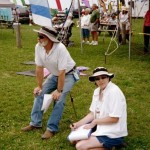 One of the biggest games this year was the Franklin Project and it, dangerously, bordered on being organized. Rick and Robyne Gardner of Port Clinton, Ohio were my two other judges. Weeks before the event we (the judges) discussed what judging criteria we would use, how we would determine “Historical Accuracy” and how we would determine Best Flight. We came up with score sheets that had 8-10 different items we would examine for Historical Accuracy. We looked at the spars, sail, construction methods and supplies. We decided that the flying line should be twine, as specified by Franklin . We also required that the contestants document everything they used to build the kite. This allowed us to check on the historical accuracy of methods and materials used by the fliers.
One of the biggest games this year was the Franklin Project and it, dangerously, bordered on being organized. Rick and Robyne Gardner of Port Clinton, Ohio were my two other judges. Weeks before the event we (the judges) discussed what judging criteria we would use, how we would determine “Historical Accuracy” and how we would determine Best Flight. We came up with score sheets that had 8-10 different items we would examine for Historical Accuracy. We looked at the spars, sail, construction methods and supplies. We decided that the flying line should be twine, as specified by Franklin . We also required that the contestants document everything they used to build the kite. This allowed us to check on the historical accuracy of methods and materials used by the fliers.
For Flight we also had determined how we wanted the kite to fly, if at all. All three of us as judges had some doubts, and more then a few concerns, mostly, about safety again. We were asking fliers to attempt to fly a kite that was basically unstable, and heavy, and that had a one foot sharp metal rod on the top.
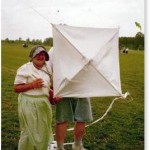 Nancy Lockwood, from Streetsboro, Ohio was one of the contestants and had her kite ready. The other contestant was Vicki Proudfoot, assisted by husband, Dean both of Tiro, Ohio. Vicki’s entry in the project was something of a surprise to me as Vicki and Deans regular kite passion is dual line pairs flying. Nancy Lockwood’s kite was the first the judges looked at for Historical Accuracy. Nancy arrived with kite in hand, dressed in what she says would have been appropriate attire for a lady shop keeper in 1752. (Nancy denies that she was attired as Deborah Franklin, Ben’s wife, who did not participate in Franklin’s experiments)
Nancy Lockwood, from Streetsboro, Ohio was one of the contestants and had her kite ready. The other contestant was Vicki Proudfoot, assisted by husband, Dean both of Tiro, Ohio. Vicki’s entry in the project was something of a surprise to me as Vicki and Deans regular kite passion is dual line pairs flying. Nancy Lockwood’s kite was the first the judges looked at for Historical Accuracy. Nancy arrived with kite in hand, dressed in what she says would have been appropriate attire for a lady shop keeper in 1752. (Nancy denies that she was attired as Deborah Franklin, Ben’s wife, who did not participate in Franklin’s experiments)
Her documentation was very detailed. She had references to the size of the 1752 handkerchief from correspondence with Kent State University’s museum. She also had comments and references from the Drachen Foundation. The size of the kite was determined from the handkerchief dimensions. This made the kite approximately 36 inches square. The kite was sparred with cedar strips. Nancy determined the size of the strips from conversations with antique furniture restorers, who said that strips of this size were commonly used in furniture manufacturing in the 1700’s
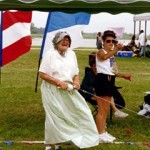 Nancy hand sewed the edges of the kite after inserting a piece of twine around the perimeter. Nancy said, “This hand sewing was most difficult. We’re so accustomed to our sewing machines doing this work! Also, my fingers aren’t as agile as they were when embroidery, knitting, etc., were easy for me.”
Nancy hand sewed the edges of the kite after inserting a piece of twine around the perimeter. Nancy said, “This hand sewing was most difficult. We’re so accustomed to our sewing machines doing this work! Also, my fingers aren’t as agile as they were when embroidery, knitting, etc., were easy for me.”
Judges Rick and Robyne gave Nancy’s kite very high Historical Accuracy scores, with the only discrepancy in how the sail was affixed to the spars. My low score for Nancy’s kite was the tail. Nancy said,” Franklin never mentioned what kind of tail he used, and the tail I have here is cotton. It will probably not fly with this tail.”
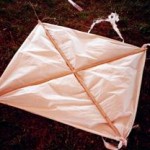 Nancy’s kite had a metal rod affixed to the top (vertical) strip of the kite as specified by Franklin. The rod was only in contact with that spar and not in contact with the flying line at all! This was another item discussed, at length, by the judges.
Nancy’s kite had a metal rod affixed to the top (vertical) strip of the kite as specified by Franklin. The rod was only in contact with that spar and not in contact with the flying line at all! This was another item discussed, at length, by the judges.
Nancy’s own comment about this category of the contest is quite revealing, “I focused on historical accuracy and decided if it flew, great, if not, well, someone else’s probably would. This is why I sought out a person who makes historical garments to confirm what I thought was the correct size of a 1750s man’s handkerchief. I knew it had nothing to do with being a nice silk Kleenex type thing.”
Despite our discussions, weeks before, about historical items, we took about twenty minutes to agree on the final Historical scores for Nancy. It was difficult not to be influenced by Nancy’s costume. Rick quoted sport kite competition rules from the IRBC saying, “Only the kite will be judged and not the flier”
Nancy’s Historical Accuracy score after we averaged the three judges scores was 36.5 out of a possible 40 points!
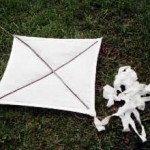 Vicki Proudfoot’s kite was smaller then Nancy ‘s and about twenty inches square. Vicki also based her kite’s size on what she believed the size of a men’s handkerchief would have been in 1752.
Vicki Proudfoot’s kite was smaller then Nancy ‘s and about twenty inches square. Vicki also based her kite’s size on what she believed the size of a men’s handkerchief would have been in 1752.
Vicki’s documentation took quite a different approach than Nancy ‘s. Her information was based on an article by Charles Garlet, published in Early American Life (1974). This article recounts a Franklin kite replica made by Paul Garber, Historian of the National Air and Space Museum.
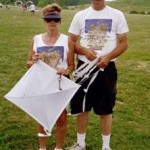 The kites spars were made out of 1/8 inch cedar branches/twigs complete with bark still attached. Some points were lost as Franklin states, “…make a cross of two light cedar strips…” So, was a twig/branch of cedar the same as a strip of cedar? Fifteen minutes of judges discussion said no and points were deducted. (I wish we had brought a dictionary to the Games!)
The kites spars were made out of 1/8 inch cedar branches/twigs complete with bark still attached. Some points were lost as Franklin states, “…make a cross of two light cedar strips…” So, was a twig/branch of cedar the same as a strip of cedar? Fifteen minutes of judges discussion said no and points were deducted. (I wish we had brought a dictionary to the Games!)
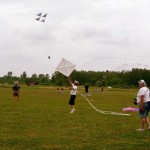 One of the major judging discussions was the method used to secure the sail to the kite. Similar to Nancy’s kite, Vicki hand sewed a hem around the perimeter after inserting a string inside the hem. But the spars were inserted inside the hem and not tied, so Vicki lost points because according to Franklin, “… tie the corners of the handkerchief to the extremities of the cross…”
One of the major judging discussions was the method used to secure the sail to the kite. Similar to Nancy’s kite, Vicki hand sewed a hem around the perimeter after inserting a string inside the hem. But the spars were inserted inside the hem and not tied, so Vicki lost points because according to Franklin, “… tie the corners of the handkerchief to the extremities of the cross…”
Concerning the sewing, Vicki mentioned her historical equivalent of Nancy’s Costume. “I hand sewed the hem of the kite by the light of a candle, which is what Franklin might have done” As Franklin was noted to be very frugal, and is credited with early comments about Daylight Savings Time, the judges doubted that Franklin would have wanted to waste the candle and probably constructed the kite in daylight, but it was a nice historic touch added by Vicki. (and not part of the final scoring)
We discussed the size of Vicki’s sail, as Franklin states,”..a large thin silk handkerchief..” and Vicki lost some points in our determining what size “large” really was. (Where is that dictionary?)
Vicki’s Historical Accuracy score after we averaged the three judges scores was 32 points out of a possible 40!
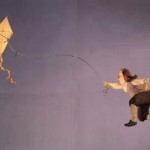 Flight judging took place on Saturday. The winds at the field were 8-12 mph and very steady off Lake Erie (which is an unobstructed 1/4 mile away) Skies were overcast and cloudy. We had already decided to give the contestants as long as they wanted to make the attempts. The judges altered (ignored) the 500 foot flight requirement, as we decided it to be a safety issue. Originally, I had decided to simulate the doorway, that Franklin said he stood inside, out of fiberglass poles and flagging tape. The fliers choose to use one of the cabanas next to the field. They would launch and then move under the cabana, to recreate the doorway that Franklin said he used to keep dry.
Flight judging took place on Saturday. The winds at the field were 8-12 mph and very steady off Lake Erie (which is an unobstructed 1/4 mile away) Skies were overcast and cloudy. We had already decided to give the contestants as long as they wanted to make the attempts. The judges altered (ignored) the 500 foot flight requirement, as we decided it to be a safety issue. Originally, I had decided to simulate the doorway, that Franklin said he stood inside, out of fiberglass poles and flagging tape. The fliers choose to use one of the cabanas next to the field. They would launch and then move under the cabana, to recreate the doorway that Franklin said he used to keep dry.
Nancy tried to launch first. She was assisted by Harry Gregory and Dean Proudfoot. Unbeknown to Nancy, this lost her some points, as Franklin claims he had one assistant (his son). Nancy’s kite would climb to about 20-30 feet and then nose over to the left or right. Vicki’s first attempt was not much better gaining no more then 30-40 feet altitude. Her kite also proved to be erratic.
The judges allowed the fliers to alternate in their attempts. Neither kite flew with any stability. (technically not flying at all) Vicki lost some points during her best flight as the flying line touched the cabana numerous times. This would have “discharged” any static collected in the line. Nancy lost points because she substituted a nylon ripstop tail to her kite which was not included in the Historical judging. ( she notified the judges of this before the flights)
Vicki’s kite “flew” the longest at 20 seconds. Neither kite ever flew correctly. All three of the judges commented on the fact that the kites seemed to be “top heavy” which seemed logical considering the one foot metal rod sticking out of the top of both kites!
The judges considered seven different items for the Flight section of the experiment. The final flight score for Nancy Lockwood’s entry was 16.5 points and Vicki Proudfoot’s score 19.5 (out of a possible 35 points total) Despite the fact that neither Nancy’s or Vicki’s kite actually flew even close to the original Franklin Project requirements, the judges decided to award the Flight prize to Vicki and Dean Proudfoot. (Two entrants – two prizes, it all worked out for the best)
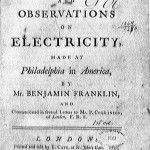 Ben Franklin is one of our countries founding fathers. He is a scientist. His writings, philosophy, and humorous sayings will be a part of American culture forever! If you choose to you could apply the adjectives “World’s most famous…” to many accomplishments by Ben! So, is Benjamin Franklin the World’s most Famous kiteflier? This was the basis for all our discussion in the Franklin Project. Ben gives other instances of his using a kite to illustrate scientific principles. To Ben a kite was only a tool he used to explore the world around him. Ben tells a story that, in his youth, he used a kite to propel himself across a lake. So, Yes, Franklin was a kiteflier!
Ben Franklin is one of our countries founding fathers. He is a scientist. His writings, philosophy, and humorous sayings will be a part of American culture forever! If you choose to you could apply the adjectives “World’s most famous…” to many accomplishments by Ben! So, is Benjamin Franklin the World’s most Famous kiteflier? This was the basis for all our discussion in the Franklin Project. Ben gives other instances of his using a kite to illustrate scientific principles. To Ben a kite was only a tool he used to explore the world around him. Ben tells a story that, in his youth, he used a kite to propel himself across a lake. So, Yes, Franklin was a kiteflier!
The main comment I heard from Midwest kitefliers was that colonial kids did have kites in 1752 and these kites did fly. A few fliers spent their explorations of Franklin searching for representations of children’s kites in the 1700’s and some examples exist, but none are to the specifications supplied by Franklin about his electric kite in 1752.
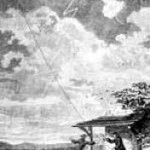 We spent the weekend of the North Coast Stunt Kite Games experimenting with the Franklin kite design. But as even Franklin would admit, only two test models do not make a proper experiment. During the weekend, as one of the judges, I watched the contest flights of Vicki and Nancy’s kites. I couldn’t help but thinking, “…that one would fly if the bridle was adjusted differently” or, “..if only there was a little more wind that kite would fly…”
We spent the weekend of the North Coast Stunt Kite Games experimenting with the Franklin kite design. But as even Franklin would admit, only two test models do not make a proper experiment. During the weekend, as one of the judges, I watched the contest flights of Vicki and Nancy’s kites. I couldn’t help but thinking, “…that one would fly if the bridle was adjusted differently” or, “..if only there was a little more wind that kite would fly…”
I kept remembering a phrase by Will Yolen, a kiteflier in New York, (a friend and comtempory of Bob Ingrahm) who said, “If you bridle it right and have enough wind, you could fly a manhole cover!” I took Vicki Proudfoot’s Franklin kite entry home with me after the weekend. I take it to the field once in a while, and maybe I’ll eventually get it to fly, given the proper conditions.
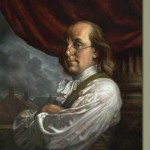 Did the Franklin Project prove that Franklin never flew his kite? You’ve all seen the clues and you can look at the links at the end of this article. See if you can figure it out! As far as I’m concerned, “the jury is still out!” Our research did not solve any deep mystery or hoax! But one of the best results of the Franklin Project came throughout the last seven months in our e-group Kitefliers-Midwest. Like any other kite related e-group we discuss local events and happenings. We also used the e-group to make the plans for the 2003 AKA National Conventions opening reception party you all liked so much! On line we spent the last seven months discussing Benjamin Franklin.
Did the Franklin Project prove that Franklin never flew his kite? You’ve all seen the clues and you can look at the links at the end of this article. See if you can figure it out! As far as I’m concerned, “the jury is still out!” Our research did not solve any deep mystery or hoax! But one of the best results of the Franklin Project came throughout the last seven months in our e-group Kitefliers-Midwest. Like any other kite related e-group we discuss local events and happenings. We also used the e-group to make the plans for the 2003 AKA National Conventions opening reception party you all liked so much! On line we spent the last seven months discussing Benjamin Franklin.
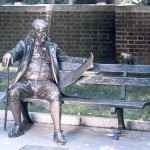 One of the comments I heard quite a lot at the Games was, “… I didn’t make a kite, but I really enjoyed reading about Franklin…” I do like to write, and it turns out that Midwest kitefliers like to read.
One of the comments I heard quite a lot at the Games was, “… I didn’t make a kite, but I really enjoyed reading about Franklin…” I do like to write, and it turns out that Midwest kitefliers like to read.
It seems appropriate to close with a quote from Benjamin Franklin:
“If you don’t want to be forgotten,
when your dead and rotten.
Write something worth reading,
or do something worth writing.”
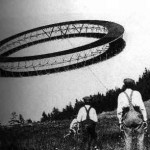 AUTHORS NOTE: Nancy Lockwood and I thought that it would be fun over this coming winter to carry on another kite research project. We plan to look at another kiteflier, one, who might really be “The worlds most famous kiteflier,” Alexander Graham Bell! Contest? Maybe, maybe not? Nancy has visited many of the places Bell used in his kite experiments, so it may prove to be an interesting discussion. One thing I know for sure is that Bell DID fly his kites!
AUTHORS NOTE: Nancy Lockwood and I thought that it would be fun over this coming winter to carry on another kite research project. We plan to look at another kiteflier, one, who might really be “The worlds most famous kiteflier,” Alexander Graham Bell! Contest? Maybe, maybe not? Nancy has visited many of the places Bell used in his kite experiments, so it may prove to be an interesting discussion. One thing I know for sure is that Bell DID fly his kites!
Good winds,
Al Hargus

